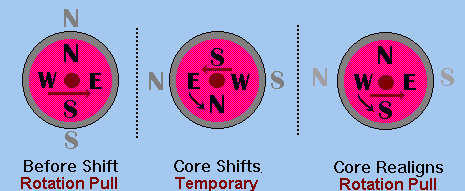
| |
 |
At every passage, as Velikovsy noted in this Worlds in Collision book, there is the potential for a disturbed orbit. Plato
mentions that the Earth had been known to rotate with the Sun rising in the west, setting in the east, not east-to-west, in the
past. The Asteroid Belt clearly shows that collisions occurred, and it would be expected that planets not reduced to rubble
might have been knocked out of their orbits, into new orbits, by this. The Earth shows evidence, in her deep history
reflecting long past events, that she did not have the sunlight, nor the land mass above water, in her past that she does today.
So, would such an occurrence happen this next passage, and might the Earth anticipate a warmer, or colder, climate based
on being nudged in toward the Sun, or out into the cold? To understand why this will not occur requires understanding of
what dictates orbits in the first place, something mankind has little grasp of. Orbits are based on an equilibrium established
between the nearby planets, who bump each other with the many particle flows that mankind is unaware of, until a status
quo is established. It is this status quo that mankind views, and assumes was there all along. This passage will put Planet X
rapidly and at close hand passing the Earth, and the Earth alone. All other planets will be spared any influence to leave
their orbits, so let us concentrate on the Earth.
The Earth is in its steady orbit because of factors so numerous that we could not list them without the audience going to
sleep, as it would take Nancy more than 24 hours to type them all. None of these factors is going to leave the area, or
change, because of a swift passage of Planet X. The only lasting influence will be that the core moves, doing a shift, and the
crust is dragged along. After Planet X passes, the Earth has all the factors that created her orbit, and her rotation, in place
as before. This is why we have stated that she will resume rotation within a day of passage. An east-to-west orbit is
presumed, because the core is still mobile, and moves in those directions based on attractions it has to elements in the solar
system. The core, of course, has been turned almost 180 degrees, during the shift, the crust not making it to that degree
before stopping. The core is mobile, and in motion already, not having stopped during the week of rotation stoppage but
continuing to strain in the direction it had.

During the shift, this motion from east-to-west does not stop, but continues, as it shifts. Thus, where temporarily it is under
an influence to move west to east, there is just as many influences to continue the east-to-west as the liquid core realigns,
without delay, reversing it’s 180 degree turn, so as to position itself with the magnetic alignment of the Sun, once again.
Where the shift was sudden, dragging the core in all its layers along with the crust, this realignment is slower and the crust
has already been separated from the core and its layers, thus remains where it is, during this realignment. The core is
mobile, and the virtual liquid factors are more mobile yet, so the competing influences resolve for the stronger force, the
magnetic realignment which the more liquid portions of the core represent. Thus, in the past, as Plato stated, the Earth has at
times turned west-to-east, but in the main rotation resumes east-to-west, which the liquid portions of the core find fits their
stretching toward their attractants. We anticipate thus, that the Earth will not only not assume a different orbit, having no
factors to knock it from its orbit, and will also resume rotation east-to-west.
The matter of a 24 hour day will not be settled for some months after the shift, though few will be concerned about this.
Rotation will be a bit erratic, faster on some days, slower on others, but will eventually settle down to something similar to
a 24 hour day. Why would this be? Because the rotation speed is dictated by the liquidity of the core, and this has not
changed.